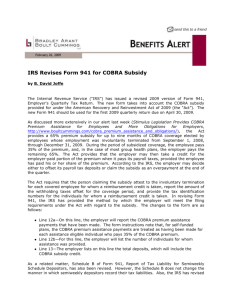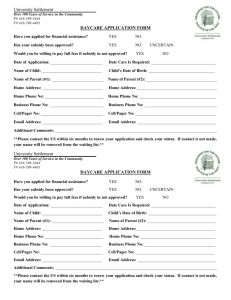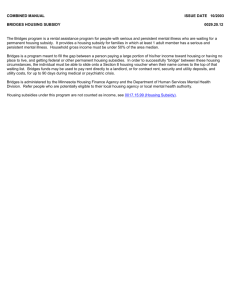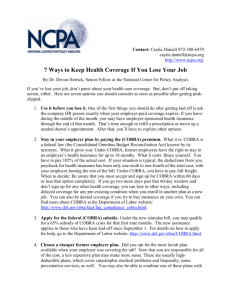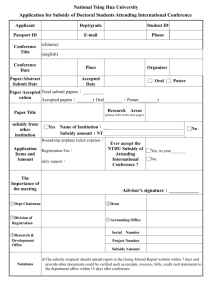COBRA: Answers for Employers - Advanced Benefit Consulting
advertisement
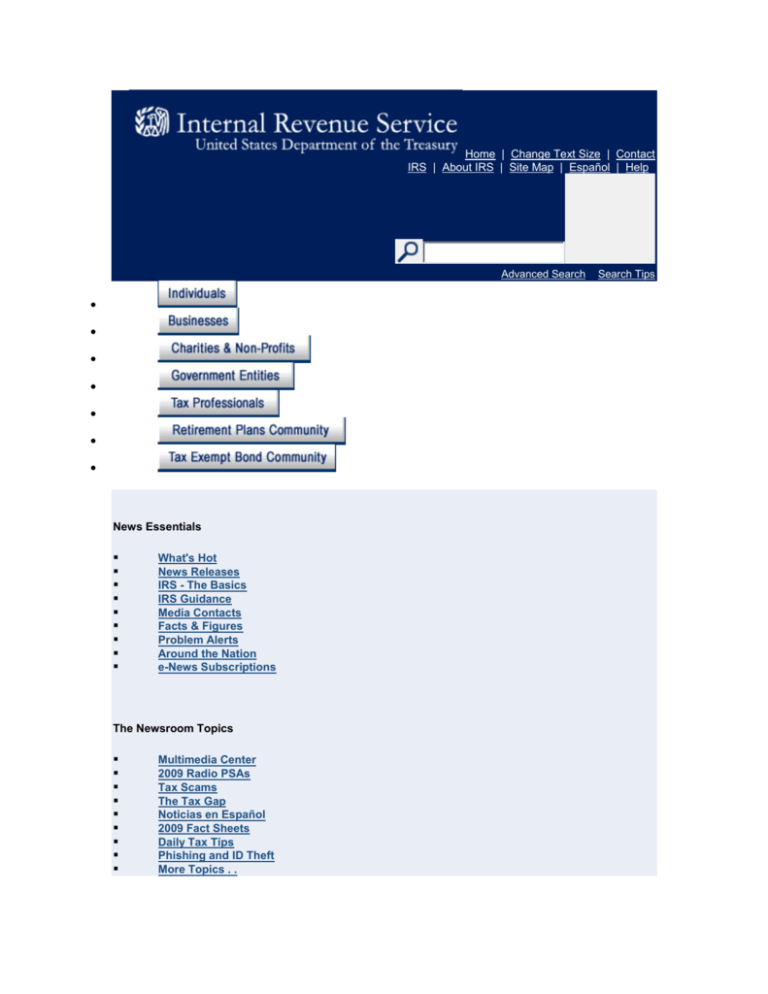
Home | Change Text Size | Contact IRS | About IRS | Site Map | Español | Help Advanced Search News Essentials What's Hot News Releases IRS - The Basics IRS Guidance Media Contacts Facts & Figures Problem Alerts Around the Nation e-News Subscriptions The Newsroom Topics Multimedia Center 2009 Radio PSAs Tax Scams The Tax Gap Noticias en Español 2009 Fact Sheets Daily Tax Tips Phishing and ID Theft More Topics . . Search Tips IRS Resources Compliance & Enforcement Contact My Local Office e-file Forms and Publications Frequently Asked Questions Newsroom Taxpayer Advocate Service Where To File COBRA: Answers for Employers Under the American Recovery and Reinvestment Act of 2009, certain individuals who are eligible for COBRA continuation health coverage, or similar coverage under State law, may receive a subsidy for 65 percent of the premium. These individuals are required to pay only 35 percent of the premium. The employer may recover the subsidy provided to assistance-eligible individuals by taking the subsidy amount as a credit on its quarterly employment tax return. The employer may provide the subsidy — and take the credit on its employment tax return — only after it has received the 35 percent premium payment from the individual. Q: How will an employer be reimbursed for the COBRA subsidy that it has provided to eligible individuals? A: The COBRA subsidy amount is reimbursed by being claimed as a credit on the Form 941. The Form 941 has been revised to allow for this credit. Q: How does an employer claim the credit for the COBRA subsidy? A: The credit is claimed on Line 12a of the January 2009 revision of the Form 941, which was posted on the IRS website on Feb. 20. In addition, the Form 941 filer also needs to include the number of individuals provided COBRA premium assistance on Line 12b. Q: What other information relating to the COBRA subsidy must be submitted with the Form 941 besides the entries on Lines 12a and 12b? A: No additional information relating to the COBRA subsidy is to be submitted with the Form 941, either electronically or in paper form. However, those claiming the credit must maintain supporting documentation for the credit claimed. Such documentation includes, but is not limited to: Information on the receipt, including dates and amounts, of the assistance eligible individuals’ 35% share of the premium. In the case of an insured plan, copy of invoice or other supporting statement from the insurance carrier and proof of timely payment of the full premium to the insurance carrier required under COBRA. In the case of a self-insured plan, proof of the premium amount and proof of the coverage provided to the assistance eligible individuals. Attestation of involuntary termination, including the date of the involuntary termination (which must be during the period from September 1, 2008, to December 31, 2009), for each covered employee whose involuntary termination is the basis for eligibility for the subsidy. Proof of each assistance eligible individual’s eligibility for COBRA coverage at any time during the period from September 1, 2008, to December 31, 2009, and election of COBRA coverage. A record of the SSN’s of all covered employees, the amount of the subsidy reimbursed with respect to each covered employee, and whether the subsidy was for 1 individual or 2 or more individuals. Other documents necessary to verify the correct amount of reimbursement. Q: The employer paid the bill and took the credit for March. In April the employer finds out that the employee did not continue his/her coverage (i.e., did not pay the 35 percent). The credit element must be allowed to be a negative, which would increase the deposit due. A: The premium subsidy and the related credit for the employer apply only after the individual has paid his or her 35 percent of the premium, so this situation should not occur. Q: I haven't seen the legislation, but why does this belong on the Form 941? A: The legislation as passed provides for reimbursement of the subsidy through the employment tax process, so Form 941 is the applicable form. Q: What will happen if Line 12a ends up being larger than Line 10 on a 941 return? Will this result in a net negative of taxes for a company? A: If Line 12a is larger than Line 10, Line 13 would also be larger than Line 10, resulting in an overpayment that could be applied to the next return, or requested as a refund. Q: Is the IRS considering any other form changes (e.g., 941X)? A: Yes. All appropriate forms are being revised and will be updated on the IRS.gov web site as soon as possible. Q. Will the due date for the first-quarter Form 941 be extended? A: No, the due date for the first quarter 2009 Form 941 is not being extended. Q: Would the number of beneficiaries need to be reported each quarter, whether or not there was a tax credit amount to apply? A: Line 12b of the revised Form 941 must indicate the number of individuals who received the total COBRA subsidy reported on Line 12a of the Form 941. If there is no tax credit amount because no subsidy was provided, then the entry on Line 12b would be zero. Q: Now that the legislation has passed, how is this going to be communicated to the employer/payroll community? A: The IRS will continue to provide updated information through this Web site as it becomes available. Q: Can an employer decide only to claim the credit at the end of the quarter rather than reducing its tax deposits during the quarter? A: Yes. The employer can decide either to offset its payroll tax deposits or claim the subsidy as an overpayment at the end of the quarter. Q: When does the law become effective? A: The law became effective on the date of enactment, Feb. 17, 2009. However, under a transition rule, the regular premium amount may continue to be paid for up to two months after enactment (e.g., for March and April), and the subsidy can be provided retroactively. Q: It was mentioned that this would be a temporary statute. How long is this change expected to be in effect? A: For assistance-eligible individuals, the qualifying event must occur on or before Dec. 31, 2009, and the COBRA subsidy may apply for up to nine months. Q: What individuals are eligible for the COBRA subsidy? A: An assistance-eligible individual can be any COBRA qualified beneficiary associated with the related covered employee, such as a dependent child of an employee, who is covered immediately prior to the qualifying event. The qualifying event for purposes of eligibility for the subsidy is involuntary termination of the covered employee’s employment that occurs during the period beginning Sept. 1, 2008, and ending Dec. 31, 2009. The individual must also be eligible for COBRA coverage, or similar state coverage, during this period. Q: Is this provision for employees who involuntarily lose their jobs — or will it apply to all employees even if they leave voluntarily? A: The credit applies only to involuntarily terminated employees and their family members who are qualified beneficiaries. Q: Will the COBRA premium subsidy be taxable income for the individual? A: The premium subsidy is not included in the individual’s income. However, there is a phase-out of eligibility for the subsidy, which will increase some high-income individuals’ tax liability if they receive the subsidy. The phase-out impacts individuals whose modified adjusted gross income exceeds $125,000, $250,000 for those filing joint returns. Tax liability is increased, to achieve repayment of a portion of the subsidy, for those taxpayers whose modified adjusted gross income is between $125,000 and $145,000, or $250,000 and $290,000 for those filing joint returns. If a taxpayer’s modified adjusted gross income exceeds $145,000, $290,000 for those filing joint returns, the full amount of the subsidy must be repaid as an additional tax. There is no additional tax for individuals with modified adjusted gross income less than these income levels. Q: When more than one entity may be responsible for receiving COBRA premiums, who should claim the credit? A: The law as enacted clarifies that the person to whom the reimbursement is payable is (1) the multiemployer group health plan, (2) the employer maintaining a group health plan that is subject to Federal COBRA continuation coverage requirements or that is self-insured, or (3) the insurer providing coverage under a plan not included in (1) or (2). Only this person is eligible to offset its payroll taxes by the amount of the subsidy. Q: Is the employer required to provide the COBRA subsidy? A: The subsidy requirement applies to group health plans that are subject to the Federal COBRA continuation coverage requirements or to similar requirements under State law. If you are an employer with such a plan and you receive a 35 percent payment from an assistance-eligible individual, you are required to make the remaining 65 percent payment. Q: What if the employer’s group health plan is self-insured? Do the subsidy requirements apply? A: Yes, the subsidy requirements apply to all plans subject to the COBRA requirements, including selfinsured plans. In that case, the employer must provide the COBRA coverage if the assistance eligible individual pays 35 percent of the otherwise required premium. The remaining 65 percent is treated as a payment of payroll taxes by the employer maintaining the plan. Q: What other agencies will provide information about the COBRA subsidy? A: Information about the COBRA subsidy will also be available through the Department of Labor and the Department of Health and Human Services, which, along with the IRS, share responsibility for the COBRA requirements. Visit the Department of Labor Web site for information related to COBRA eligibility and the subsidy. Benefits Advisors are also available to assist you at 1-866-444-3272. Return to COBRA Health Insurance Continuation Premium Subsidy. Return to IRS Information Related to Tax Provisions in the American Recovery and Reinvestment Act of 2009. Page Last Reviewed or Updated: February 26, 2009 Accessibility | Freedom of Information Act | Important Links | IRS Privacy Policy | USA.gov | U.S. Treasury
